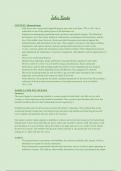John Keats
CONTEXT: (Romanticism)
- John Keats was a renowned English Romantic poet who lived from 1795 to 1821. He is
celebrated as one of the greatest poets of the Romantic era
- England was undergoing significant social, political, and cultural changes. The Industrial
Revolution was in full swing, leading to urbanisation, technological advancements, and the
rise of the middle class. However, Keats and other Romantic poets reacted against the
industrialisation and rationalism of the time. They sought to reconnect with nature, embrace
imagination, and express intense emotions and personal experiences in their works.
- It was a reaction against the rationalism and scientific mindset of the Enlightenment period
and emphasised the importance of emotion, imagination, individuality, and the appreciation of
nature.
- Was in love with Fanny Brawne.
- Despite these challenges, Keats and Brawne remained deeply attached to each other.
However, their love story was cut short by tragic circumstances. Keats contracted
tuberculosis, and his deteriorating health forced him to leave England and seek medical
treatment in Italy. Before departing, Keats and Brawne were engaged to be married.
- Due to his declining health, he was not able to go out with Fanny resulting in him writing
negatively in his portrayal of women in much of his work.
- Fanny Brawne, devastated by his death, remained unmarried for the rest of her life and kept a
collection of Keats's letters and mementos as cherished possessions. Link to Isabella.
- 1818, 1819
ISABELLA/THE POT OF BASIL
Summary
The poem begins by introducing Isabella, a young woman of noble birth, who falls in love with
Lorenzo, a lowly employee in her brother's household. They secretly meet and share their love, but
Isabella's brothers discover their relationship and are angered by it.
Isabella's brothers plot to kill Lorenzo to protect the family's reputation. They ambush him in the
woods and brutally murder him, burying his body and deceiving Isabella into believing he has left
town. Isabella, devastated by the loss, grieves for Lorenzo.
One night, Lorenzo's ghost appears to Isabella in a dream and reveals the location of his buried body.
Isabella goes to the woods and finds the grave, where she unearths Lorenzo's skull. She takes it with
her and places it in a pot of basil, which she tends to lovingly and uses it as a symbol of her eternal
devotion to Lorenzo. Her brothers find the pot of basil and hide it, she spends the rest of her life
looking for it. They took her love twice.
Analysis
- The poem portrays a passionate and forbidden love between Isabella and Lorenzo, which is
ultimately torn apart by societal constraints.
- Keats incorporates supernatural elements into the poem, such as Lorenzo's ghost appearing to
Isabella in a dream. This adds an otherworldly dimension to the story and enhances the theme




